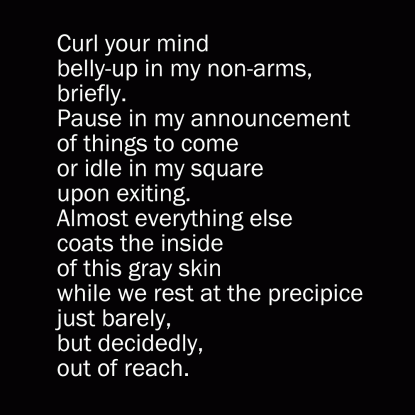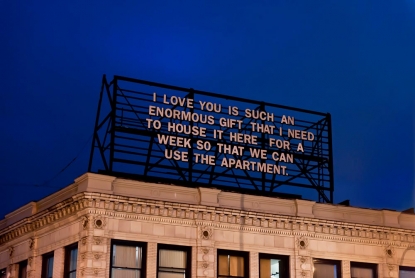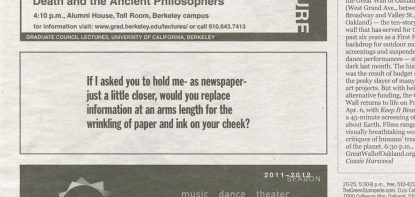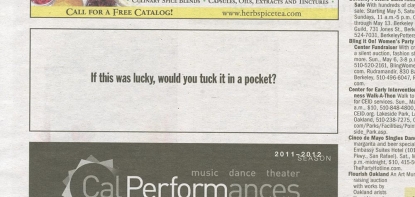Panel #1 Installation view (2012), Kari Marboe, 4x4’, Digital print on vinyl, mounted on Cintra, Installed at the Bancroft entrance to the Berkeley Art Museum

Panel #1 (2012), Kari Marboe, 4x4’, Digital print on vinyl, mounted on Cintra, Installed at the Bancroft entrance to the Berkeley Art Museum

Billboard #1, (2012) Kari Marboe, one-week installation on top of the Waffle Shop in Pittsburgh, PA. 4x6’, photographic print mounted to acrylic with aluminum backing
Feature: Reviews
Kari Marboe
- The 42nd Annual UC Berkeley MFA Graduate Exhibition
- Berkeley Art Museum
- May 18 - June 10, 2012
It’s only natural in a world where viral forms of art and marketing coexist and sometimes collaborate, that we increasingly see these forms intermingling. Two of the most successful practitioners are Shepard Fairey and Jeff Hull. The former's “Obey Giant” campaign spread stickers throughout the country and eventually the world – most often with an image of deceased wrestling icon Andre the Giant branded with the satirically ominous propagandistic slogan “OBEY”. The word was a reference to the cult film They Live (which coincidentally starred a former wrestler who once tussled with Andre). In They Live, OBEY was the subliminal message underlying all ads and media, placed there by nefarious aliens with undue intentions for the future of the planet.
Mr. Hull's Games of Nonchalance redefined the genre of Alternate Reality Gaming, offering up a interactive quest involving street and performance art in nearly equal amounts essentially forcing the participant to actively reengage with their local environment and learn the all too true and strange history of San Francisco. These two men's works reexamine the questions posed by history and the very nature of existence in a world over-saturated with media coverage and advertising.
The work of a young female Bay Area-based artist, Kari Marboe, seems to fall in this same milieu, working to pose questions and provoke an investigative line of reasoning. Of the six artists on display at Berkeley Art Museum for The 42nd Annual UC Berkeley Master of Fine Arts Graduate Exhibition, I found hers to be the most compelling for further examination.
Marboe’s works comprise a series that operate on a physical, conceptual and ephemeral level. The main series Newspaper Spaces #1-7, is a series of seven Brancusi – like columns of newspapers stacked high on four slightly elevated platforms placed middle of the museum's floor. There are two additional works that seem to be of a series as they both include the number one in their titles. To be clear, there are no corresponding sequential works that form a connective tissue – merely the suggestion exists. The first of these could be easily missed by those perhaps too eager to get their museum visit on – in other words, folks like me. Panel #1 takes the place of an ad and could easily be confused for one. It reads:
“Curl your mind belly-up in my non-arms, briefly. Pause in my announcement of things to come or idle in my square upon exiting. Almost everything else coats the inside of this gray skin while we rest at the precipice just barely, but decidedly, out of reach.”
So? Well, one has to enter and exit the museum and be observant to get it. A sort of unintended comment of the strange phenomena of people rapidly, in succession, taking pictures of themselves in front of major works such as the Mona Lisa? This after spending mere seconds considering their camera angles and possibly not much of the art they are peering at!
This is literary art that succeeds as advertising and commentary; blurring boundaries and inadvertently raising some of the issues Tom Wolfe famously noted in his art world take down, The Painted Word. In Wolfe’s fighting words:
“How could Modern Art be literary? As every art-history student is told, the Modern movement began about 1900 with a complete rejection of the literary nature of academic art, meaning the sort of realistic art which originated in the Renaissance and which the various national academies still held up as the last word. Literary became a code word for all that seemed hopelessly retrograde about realistic art.”
Was he right or wrong? I say half right and I well imagine he would have found Marboe’s work amusing, but not to his taste. In the book, Wolfe, posits a thesis that in the contemporary art world, post-modernism has created a place where theory wins out over craft, leftwing political messages are usually necessary in some shape or form, or in the case of ephemeral works, lack of form. He goes on to put forward the idea that literary narrative has displaced representation. Finally and most relevantly he makes the case that the art market has indeed profited greatly from these changes in the art world. Given that this book came out in 1975, one would well imagine that it has dated poorly. Aside from the over-the-top style and its just to the sarcastic right of Hilton Kramer politics – much of the criticism holds water; that being that the market holds too much sway over the art community and much of contemporary art is indeed literary. A lot of this type of work is cloying and fails at delivering its intended message(s). There are successful practitioners, however. Barbara Kruger and Ed Ruscha are two examples. To each his or her own – Kari Marboe's work won me over.
As the artist describes, “Billboard #1 was a one-week installation on top of the Waffle Shop in Pittsburgh, PA that is now shown to others beyond the site as a photograph. The piece is an example of site-specific storytelling where the narrative is closely and forever linked to the site where it is presented in both thematic and physical ways. (printed 4x6’, mounted to acrylic with aluminum backing)"
Like much of Mark Dion's work, it consists of an idea executed by others in a location somewhat foreign to its creator and exists as an opportunity for reflection and re-contextualization. It lived in Pittsburgh, Pennsylvania. It was documented by a wedding photographer with generous organization assistance provided by John Rubin. It too features a message:
“I love you is such an enormous gift that I need to house it here for a week so that we can use the apartment.”
As Marshall McLuhan once noted:
“A commercial society whose members are essentially ascetic and indifferent in social ritual has to be provided with blueprints and specifications for evoking the right tone for every occasion.”
The artist's take?
“I wrote this for my boyfriend when we were moving in together... I wrote it to myself in the night and then I did it and then I gave him the picture.”
My take? The deepest of personal sentiments carried to a level of eloquence that could outfly an aeroplane towing a banner asking “Will you marry me, x?”
The last series, perhaps a complete one, was created by Marboe in collaboration with Erin Johnson and is described thusly:
“Newspaper Spaces #1-7 is a text/image series that resides in the East Bay Express from April 4-May 16, 2012. Each individual piece acknowledges its material nature as newspaper while pushing the boundaries of what other functions may be layered on top of that space. We’ve created unexpected moments to shift perception of how newspapers function by asking it to be held tenderly, letting readers wish on its pages, adding qualities through questions, and creating a vacant lot in the midst of a complex city where the distracted viewer is able to take a deep breath and look around for a moment.”
To elaborate, the artists placed images as ads into the pages of the East Bay Express, a prominent Bay Area weekly newspaper, with perhaps a viral intent. In an elusive and vague order, they consisted of a message, an image of a wishbone, the digital date of 11:11, three more messages, and a blank rectangle left as space to be altered or perhaps be pondered upon. One of the messages, the first, provides instruction: “If I asked you to hold me – as newspaper – just a little bit closer, would you replace information at an arms length for the wrinkling of paper and ink on your cheek?” Another one poses a question which is serves as compliment to the wishbone image: “If this was lucky, would you tuck it in a pocket?”
What of the response to this? Well, this one recounted to me by Marboe, stood out to me as most thought provoking:
“One little boy called the EBX about one of my images in the paper that referenced the date 11/11/11 worried about the seemingly apocalyptic implications! We had to explain to him that this piece was about the idea of creating a “wish object” to place into the paper... we had to reassure him. I really wanted to tell him that his worries were true! BUT I couldn't do that...”
Marboe goes on to add “The paper weathers so quickly you can tell the oldest individual paper from the newest one.” They are stacked at least a hundred papers thick in columns.
I am left with but one lasting thought having experienced this exhibition: For work that exists in both a conceptual and physical framework, one does not necessarily need to be in its presence to feel its power. Whereas the influential one time New York Times critic Hilton Kramer once dismissed conceptual art as 'scrapbook art” and Tom Wolfe goes even further calling most contemporary art shamelessly commercial and pandering conceptualism lacking in basic craft. Surely they are right about much of the art market's excesses and much of the art being thrust out for serious consideration and even more serious sales. That said, such a rubric excludes people like Joseph Cornell or Banksy, whose film slash conceptual prank Exit Through the Gift Shop has proved to be one of the best “takedowns” of art world excess thus far. I think this Banksy quote could likely go into a sequel to The Painted Word: “Modern art is a disaster area. Never in the field of human history has so much been used by so many to say so little.”
Fittingly over the top, eh? Art need not be maximal or minimal, it needs to and should say something – though not necessarily something explicit. It should be true to the artist's intent and successful art usually is. In many artist's studios, there is a wall filled with clippings of images of great works and quotes. There is something spiritual, even religious about such an action. Perhaps Kari Marboe was wryly asking if her work will make it up on an wall somewhere with this newspaper message:
“If this was sacred, would you build it an altar?”


